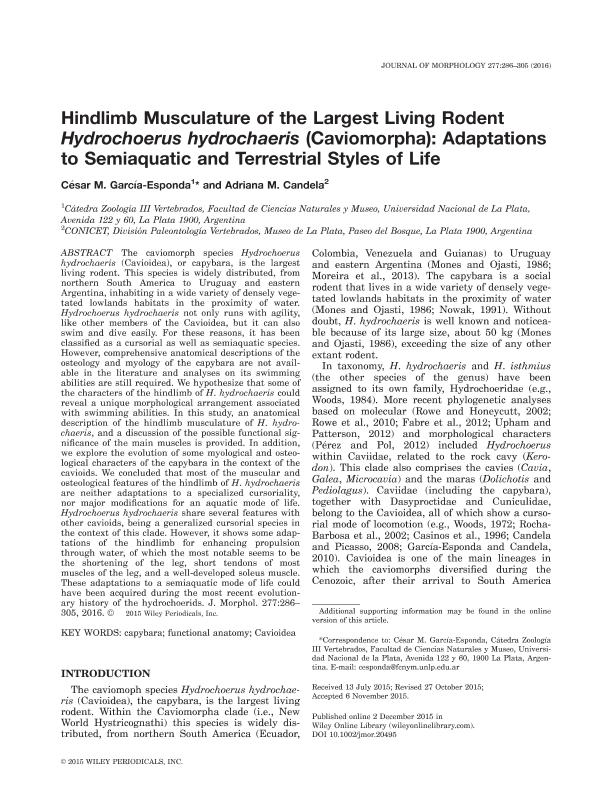Mostrar el registro sencillo del ítem
dc.contributor.author
García Esponda, César M.
dc.contributor.author
Candela, Adriana Magdalena

dc.date.available
2018-08-09T19:56:54Z
dc.date.issued
2016-03
dc.identifier.citation
García Esponda, César M.; Candela, Adriana Magdalena; Hindlimb musculature of the largest living rodent Hydrochoerus hydrochaeris (Caviomorpha): Adaptations to semiaquatic and terrestrial styles of life; Wiley-liss, Div John Wiley & Sons Inc; Journal of Morphology; 277; 3; 3-2016; 286-305
dc.identifier.issn
0362-2525
dc.identifier.uri
http://hdl.handle.net/11336/54867
dc.description.abstract
The caviomorph species Hydrochoerus hydrochaeris (Cavioidea), or capybara, is the largest living rodent. This species is widely distributed, from northern South America to Uruguay and eastern Argentina, inhabiting in a wide variety of densely vegetated lowlands habitats in the proximity of water. Hydrochoerus hydrochaeris not only runs with agility, like other members of the Cavioidea, but it can also swim and dive easily. For these reasons, it has been classified as a cursorial as well as semiaquatic species. However, comprehensive anatomical descriptions of the osteology and myology of the capybara are not available in the literature and analyses on its swimming abilities are still required. We hypothesize that some of the characters of the hindlimb of H. hydrochaeris could reveal a unique morphological arrangement associated with swimming abilities. In this study, an anatomical description of the hindlimb musculature of H. hydrochaeris, and a discussion of the possible functional significance of the main muscles is provided. In addition, we explore the evolution of some myological and osteological characters of the capybara in the context of the cavioids. We concluded that most of the muscular and osteological features of the hindlimb of H. hydrochaeris are neither adaptations to a specialized cursoriality, nor major modifications for an aquatic mode of life. Hydrochoerus hydrochaeris share several features with other cavioids, being a generalized cursorial species in the context of this clade. However, it shows some adaptations of the hindlimb for enhancing propulsion through water, of which the most notable seems to be the shortening of the leg, short tendons of most muscles of the leg, and a well-developed soleus muscle. These adaptations to a semiaquatic mode of life could have been acquired during the most recent evolutionary history of the hydrochoerids.
dc.format
application/pdf
dc.language.iso
eng
dc.publisher
Wiley-liss, Div John Wiley & Sons Inc

dc.rights
info:eu-repo/semantics/openAccess
dc.rights.uri
https://creativecommons.org/licenses/by-nc-sa/2.5/ar/
dc.subject
Capybara
dc.subject
Cavioidea
dc.subject
Functional Anatomy
dc.subject.classification
Otras Ciencias Biológicas

dc.subject.classification
Ciencias Biológicas

dc.subject.classification
CIENCIAS NATURALES Y EXACTAS

dc.title
Hindlimb musculature of the largest living rodent Hydrochoerus hydrochaeris (Caviomorpha): Adaptations to semiaquatic and terrestrial styles of life
dc.type
info:eu-repo/semantics/article
dc.type
info:ar-repo/semantics/artículo
dc.type
info:eu-repo/semantics/publishedVersion
dc.date.updated
2018-08-09T15:17:30Z
dc.journal.volume
277
dc.journal.number
3
dc.journal.pagination
286-305
dc.journal.pais
Estados Unidos

dc.description.fil
Fil: García Esponda, César M.. Universidad Nacional de La Plata. Facultad de Ciencias Naturales y Museo; Argentina
dc.description.fil
Fil: Candela, Adriana Magdalena. Universidad Nacional de La Plata. Facultad de Ciencias Naturales y Museo. División Paleontología Vertebrados; Argentina. Consejo Nacional de Investigaciones Científicas y Técnicas; Argentina
dc.journal.title
Journal of Morphology

dc.relation.alternativeid
info:eu-repo/semantics/altIdentifier/doi/http://dx.doi.org/10.1002/jmor.20495
dc.relation.alternativeid
info:eu-repo/semantics/altIdentifier/url/https://onlinelibrary.wiley.com/doi/abs/10.1002/jmor.20495
Archivos asociados
